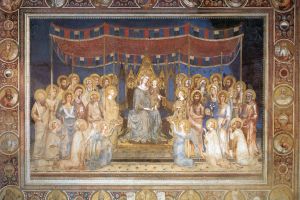The other Maestà
Introduction
To understand fully the people of Siena’s devotion to Mary, besides looking at the Cathedral, the Collegiate Church of Provenzano and the Basilica di Santa Maria dei Servi, we cannot avoid another “domus Virginis,” the Palazzo Pubblico, Siena’s town hall. Inside is a work that is considered one of the greatest masterpieces of European Gothic paintings, because of the profound civic and religious meanings it communicates and its extraordinarily innovative formal language: the Maestà by Simone Martini. Soon after Duccio painted his great Maestà for the high altar of Siena Cathedral, which was finished in 1311, the government of Siena, run at the time by nine members of the wealthy merchant class – hence the name “the Government of the Nine” – commissioned Simone Martini to paint a fresco on the same subject, which he finished in 1315. The fact that the city authorities wanted to have a Maestà right in the seat of government confirms the civic significance of Sienese devotion to the Virgin Mary. And the site chosen for the work is of primary importance: the painting occupies an entire room of the largest and most emblematic room in the Palazzo, known as the Sala delle Balestre (Room of the Crossbows) or del Mappamondo (of the Map), where meetings of the General Council were held. Compared to Duccio’s painting, the fresco presents the same iconographical . . .



